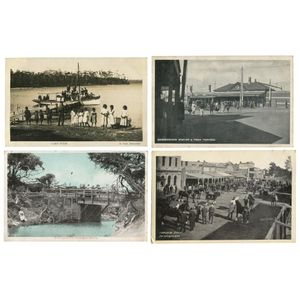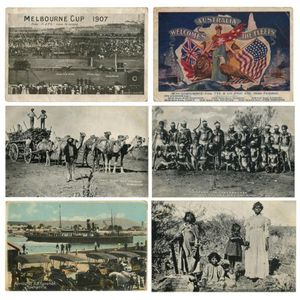![[Aboriginal Interest]. A hand-coloured postcard titled 'Lubras'…](https://img.carters.com.au/300x300/46faab039b8615037bee54546e89b93d.jpg)
Lubras Camp at Maloga: Aboriginal Cultural Heritage Collection
[Aboriginal Interest]. A hand-coloured postcard titled 'Lubras' camp at Maloga, Vic.' with versions (or parts) of the same image appearing in a black & white magic lantern slide titled 'Group of Natives on the Murray', a hand coloured magic lantern slide,…

Australian Postcards: Indigenous Culture, Rural Life, and Local Landmarks
Postcards: Australian Themes, including 'Queensland Aboriginals tree Climbing', 'Bullock team, drawing 12 Tons wool, Queensland', 'Post office, Traralgon' plus novelty cards and other (100)

Australian Aboriginal Lubra and Other Australian Subjects Postcards (3)
Swain & Co. 'Australian Aboriginal Lubra' undivided back Rp postcard; plus 2 other Australian subjects. (3).

Discover Australia's Diverse Landscapes: A Postcard Collection
Australian Postcards album including Aboriginal interest, Dandenong Ranges, Ovens River, Railway Workshops and Yards Ipswich Queensland, Sandringham Station and Tram Terminus, examples by Kerry, The Grampians, Parade Day Horsham and many more. Inspection…

Rare Postcards: A Diverse Collection of Impressive Memorabilia
Postcards. An impressive album with a diverse range including some rarities. Of note Aboriginal, Titanic, Great White Fleet, Australian towns, Camel teams, 1907 and 1908 Melbourne Cup, Prahran, Kyneton, Kalgoorlie, Gold Mining, Kilmore, Mining Disasters,…

Assorted Australian Postcards (90+)
Australian Postcards: An accumulation including Aboriginal subjects, American Fleet types, several J.A. Turners, Swain & Co., T. Willmett & Son North Queensland Railway and Mining types, Nellie Stewart cards by Harcourt McGuffie, Hobart; street scenes,…

Early 1900s Real Photo Postcard Collection
Postcards: A small collection of (13) mainly real photo cards, circa 1905-10, with subjects including 'Aboriginals & Canoe' by Cooper, 'The First Cobbs' Coach Imported from America, Delivering H.M. Mails to the Natives at Coranderrk.', 'Crossing the…

Aboriginal Postcard Collection from early 1900s
Postcards: Aboriginal Subjects, collection of (43) real photo cards, circa 1905-10, almost all postally used and the subjects mainly from identified locations: Queensland (5), South Australia (2), Tasmania (2), Victoria (10), Western Australia (14), and…

Vintage Postcard Collection Featuring Various Themes
Postcards including Ida Rentoul Outhwaite, Aborigines, Singer Sewing Machine, Viceroy Tea, S.T. Gill, real photograph, novelty and others (68 items)

Namatjira's Hermannsburg Landscapes Postcards (2nd & 3rd Series)
Albert Namatjira: Two sets of six colour postcards of the artist's Hermannsburg landscapes, 2nd and 3rd series in original covers, circa 1950s, 11 x 16 cm

Early Aboriginal Photographs and Postcards
Two early photographs of Aborigines, depicted with a dugong, from the north West Scientific & Exploration Syndicate WA, and a portrait, from W. Norton, Sydney, together with early postcards

Brisbane Studio Portraits and Rare Aboriginal Elder Photograph
Collection of Brisbane Studio portrait photographs and postcards, including a rare photograph of Mr and Mrs Logan depicting Aboriginal elders

Diverse Postcard Collection: 350+ Cards
Postcards: Interesting collection of cards including Australian real photographs, New Zealand, Fry's Cocoa, Golliwogg, ships, Aboriginal, Great War tanks, French, English, Continental and others, inspection will reward, (350+ cards)

Rare Postcard Pair: Bates' Beagle Bay & 1915 Rose Series
Two postcards, one Scarce Daisy. M. Bates postcard 'Native Camp at Beagle Bay', together with a 1915/16 Rose Series postcard

Vintage Postcard Collection including Rosebud and Aboriginals
Collection of vintage and antique postcards including real photograph street scenes of Rosebud and Dromana, Aboriginals, aviation, Roses Series, Olinda, Monbulk, country towns etc. Inspection will reward. (220+ cards)

Snapshot Australia: Postcards and Photographs
Album of postcards including Australian country towns, Louis Wain, real photograph Aboriginals, 'Coakley's Royal Hotel Daylesford', the Australian Cricket Team etc. 110+ items

Vintage Postcard Collection: Aborigines, Portland, Advertising & More
Album of vintage postcards including Aborigines, real photographs of Portland, advertising etc. Well worth inspection.

World Tour Postcard Album, 1907
An impressive early 20th century post card album featuring approx 950 postcards of a world trip which encompasses Australia, New Zealand, Ceylon, America, Canada, United Kingdom, also with signed Maggie Papakura postcards, the last Aboriginals of Tasmania…

Victorian Postcard Album with Aborigines and Country Towns
C1910-80s postcards in album, noted two nice real photo postcards of Aborigines at Bairnsdale 1912; some nice scenes of Victorian country towns. Fair/G condition. (94 items). E x 1930s speedway champion Frank Apted.

Rare Postcards: Aboriginal, Aviation, Advertising & More
Attractive group of postcards; noted themes, Aboriginal, advertising, aviation 'Walsh Bros Seaplane Flying Over Auckland Harbour C1916', Mabel Lucy Attwell etc. Some very rare cards. (73 items)

Early 20th Century Postcard Album
Postcard Album. Over 100 cards (early 20th century), English, Japanese, French and Australian. Noted Aboriginals (2), London Exhibition 1908, Cricket 'M.M.C. Australian 1907-8 Team'. Housed in a period album. (100+)
 Loading more...
Loading more...